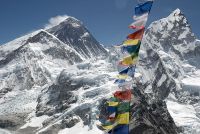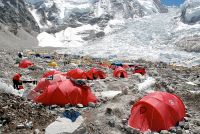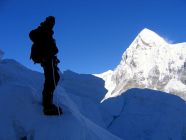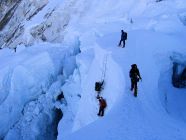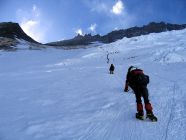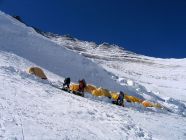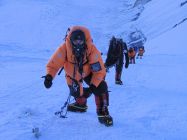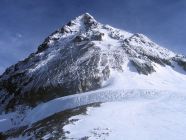I led this expedition for Jagged Globe. This is a copy of the report that I wrote for their website. This was my 4th Everest Expedition.
On 23rd May eleven members of the expedition reached the 8848m summit of Mt Everest. This was Jagged Globe's 13th Mt Everest Expedition and the 10th to climb the classic SE Ridge Route on the Nepalese side of the mountain. The climbing team had equal numbers from England, Scotland and Ireland. They were supported by Summit Trekking's excellent crew of climbing Sherpas, many of whom work with Jagged Globe every year.
2008 was a strange year for Everest climbers. More than a year in advance it had been known that the Chinese intended to stage an ascent of Mt Everest as part of the preparations for the 2008 Beijing Olympic Games. In the months before this planned ascent reassurances were given by the CMA (Chinese Mountaineering Association) and the TMA (Tibet Mountaineering Association) that this climb would not interfere with the activities of any foreign climbing teams on the North (Tibetan) side of the peak.
In the aftermath of anti-Chinese riots in Lhasa during Spring 2008 the Chinese authorities announced a few weeks before the start of the Mt Everest climbing season that all permits to climb the mountain from Tibet were being withdrawn. Some teams intending to climb on the North side of Mt Everest decided to delay their climbs until 2009 and it was thought that several teams were hoping to transfer to the Nepalese side. Around the same time there were rumours that the Chinese Government was putting pressure on the government of Nepal to restrict the activities of climbers on their side of the mountain to prevent anti-Chinese protests on Mt Everest during the Chinese climb.
As climbers prepared to travel to Kathmandu towards the end of March it was unclear if the Nepalese Ministry of Tourism would be issuing permits to Climb Mt Everest for the 2008 season, and if so, what restrictions would be placed on the climbers. Rumours were rife, and there seemed to be a real possibility that the South side of Everest could either be dangerously overcrowded or closed altogether. It was not ideal for the seven climbers and two leaders in the Jagged Globe team to start their expedition in such a climate of uncertainty.
From March 25th until April 5th the team trekked along the Khumbu Valley towards Base Camp, climbing a few easy 5000m hills along the route. Meanwhile our sherpa team had been hard at work in Base Camp (5360m) preparing an excellent site for the collection of 20 tents that were to be our home for the next 7 weeks.
The first 11 days in Base Camp gave everyone time to settle in. There was a surprising amount of work to be done around Base Camp to ensure that everyone would have a comfortable stay. All the food and equipment needed sorting, and the power supply and communications equipment required to be connected and tested. One highlight of this period was the Puja (Buddhist blessing ceremony) on April 11th that involved quite a bit of sitting in the sun listening to chanting, followed by a fair bit of drinking and dancing. No work was done on that day!
By this time the Nepalese Army had arrived in base camp with orders to prevent any anti-Chinese demonstrations at Base Camp or on the mountain, and to severely limit climbers' communication with the outside world by telephone or email. Despite some dramatic reports that reached the outside world the Army personnel were mostly easy-going and courteous to the climbers and relations were good.
After a few training trips into the lower icefall it was time to make the first climb to Camp One (6060m) on April 18th where most of the team spent the night before returning to Base Camp. The route through the Khumbu Icefall from Base Camp to Camp One has a reputation for being both difficult and dangerous. However, the team benefited from the previous day's practice sessions (ladder crossings, jumaring, abseiling) and most agreed that the icefall was easier than they had expected. Making an early start to avoid the crowds and the daytime heat was also a big help.
The team climbed to Camp One for a second time on April 22nd. This time they stayed for two nights, making a round trip to visit Camp Two (6410m) on April 23rd where they were able to witness the work done by our sherpas preparing sites for our tents. The weather remained very stable throughout this period and the group were able to plan a climbing programme for several days ahead without fear of disruptions caused by bad weather.
The third climb onto the mountain led to the first overnight stay at Camp Two. Everyone climbed to Camp One on April 28th, and then on to Camp Two on April 29th. Camp Two had been very well set up by the sherpa team. Each climber had their own tent and there was a well-stocked sherpa kitchen and large dinning tent. The main problem was the interior of the dinning tent getting too hot in the daytime sun. Not the sort of thing one expects at almost 6500m!
By the afternoon of April 30th the team were all back in Base Camp and looking forward to the next trip onto the mountain that would enable everyone to sleep at Camp Three. At this point it became clear that the Nepalese Army were under instructions to prevent all climbers (foreigners and sherpas) from climbing above Camp Two until after the Chinese expedition on the North side of the mountain had completed their ascent. The stable weather pattern of the previous weeks seemed to be changing. The temperatures had been steadily rising and the 24-hour clear skies had given way to a pattern of clear mornings followed by cloudy afternoons with a few centimetres of daily snowfall. Despite this there was little evidence of high winds on the summit and we were hopeful that the Chinese would reach the summit in a few days time thus enabling all the teams on the South side of the mountain to climb higher than Camp Two.
This enforced rest at Base Camp lasted a few more days than we would have ideally preferred, but as soon as we learnt of the successful climb of the Chinese team on May 8th we were ready to launch the next phase of our own ascent. The sherpas prepared Camp Three (7200m) on May 10th and the team moved up to spent the night there on May 11th. The prospect of climbing the steep Lhotse Face had seemed daunting to some of the team but in reality it posed few problems. There were two parallel fixed lines, one for 'up' traffic and one for 'down'. The only difficulty was that no one seemed to agree which was which! The ropes were of good quality and the few short steep 'steps' were interspersed with sections of easier ground. An early start from Camp Two saw several members of the team resting in Camp Three by 08.00 in the morning.
On returning to Base Camp on May 13th we were able to prepare our summit plan with a fair degree of confidence that the stable weather pattern would hold into the foreseeable future. The sherpas needed a few days to carry loads (6 tents, 30 kg of food, 24 gas cans, 74 bottles of oxygen, etc) to Camp Four at the South Col. Therefore we aimed to make our summit day on May 23rd. The sherpas set about their work high on the mountain and several members of the climbing team chose to trek down the valley below Base Camp for some rest at a lower altitude.
By May 17th everyone was back at Base Camp and the weather forecast was looking good for the week ahead. Base Camp Manager Mara, made plans to support the team on the mountain by radio from Base Camp. Early in the morning of May 19th all seven climbers, plus two leaders, left Base Camp to join the sherpa crew waiting in Camp Two. The climbers were all strong and in good spirits. The weeks of training and acclimatisation climbs had seen everyone improve their technique and increase the speed and efficiency of their movements on the mountain. We were confident that all of the team had a very good chance of reaching the summit in a few days time.
Everyone reached Camp Two without incident early on May 19th and spent a relaxing time resting there the following day. A straightforward early start on May 20th was only interrupted by the sad news that Ron had strained a muscle in his side during the night and he announced over an early breakfast (03.30) he would be unable to continue with his climb. As he returned to Base Camp the rest of the team continued onwards to Camp Three with most of them arriving between 09.00 and 10.00, leaving plenty of time for a relaxing day of sleeping, eating and reading.
The next day was new ground for everyone: the climb to Camp Four (7900m) on the South Col. The initial section on leaving Camp Three was quite steep for the first few hundred meters as it climbed straight up the steep icy face. The rocky barrier of the 'yellow band' was crossed and the route continued upwards for another few hundred meters. Then the trail took a sharp turn to the left and the route changed into a gently rising traverse heading towards the rocky outcrop of the Geneva Spur. The route here was a straightforward path along a narrow ledge, well protected by fixed ropes, but there was a sting in the tail, as the final section required a strenuous pull up a short section of steep rock. The fine weather of the early morning slowly gave way first to mist and fog, and later to gentle snowfall. Visibility at Camp Four was poor by the time the team arrived between 11.30 and 12.30.
The afternoon and evening passed quickly. The basic tasks of melting snow, cooking and eating seemed to expand to fill the available time and after a short sleep it was 21.00 and time to start the climb to the summit. We knew by this stage in the expedition that the summit had been reached by the first climbers of the season two days previously on May 21st and again on May 22nd. Fixed ropes had been placed on the summit slopes and the way ahead to the top was 'open'.
Climbers were 'paired' with an individual sherpa who carried their additional bottles of oxygen. It was a clear, windless, moonlit night as climbers and sherpas struggled with their clothing and equipment in the faint pools of light shining from their headlamps. Soon they were on the move heading for the string of lights moving on the trail ahead. Several other teams had made an earlier start from camp and they were already several hundred meters in front.
Most of these climbers were moving slower than our group and we passed the majority before the 'Balcony'. However, one consequence of having to pass so many people was that the sub-groups we had planned for had become fragmented. The lead group (James, Martin and David, plus their 4 sherpas, Mingma, Tsiring, Pasang and Lila) reached the Balcony (c8500m) just after midnight. Ian and Pema were about 40 minutes behind them at this stage. Graham, Tim, Adele and Janet, plus their 4 sherpas, Dawa, Pem, Nima and Wangchu) reached the vicinity of the Balcony around 02.00. Graham and Tim reluctantly decided that they were not feeling strong enough to continue and turned around at this point, with Dawa and Pem, returning safely to the South Col in a few hours.
The lead group arrived on the South Summit at 03.46. James and Martin had experienced some icing on the outside of the ambient air inlet valves of their oxygen masks. Once this problem had been identified we worked together to clear the ice build up and they took a brief rest to change their oxygen bottles on the South Summit. The tracks from South Summit to main summit had drifted over with new snow since the ascents of the previous day. David and Pasang pushed on to break trail to the summit. At the foot of the Hillary Step they received a radio call from the group on the South Summit to say that Martin was having problems with his eyesight and intended to descend with his sherpa, Tsiring. Martin was very unlucky not to have reached the summit. He had completed more than 99% of the work needed to get to the top. He was strong and had climbed with good style to reach the South Summit in 7 hrs from the South Col. But it was clearly unsafe for him to continue with seriously impaired vision and he made the wise choice to descend. Fortunately his sight returned within a few hours and he sustained no permanent damage.
David and Pasang pushed on to the summit arriving at 05.00, a few minutes after the first rays of dawn. David took a few photographs of the surrounding mountains in the blue light of early morning. The moon was visible to the South high above the tiny peak of Ama Dablam. To the West towards the summit of Cho Oyu the vast pyramid shaped shadow cast by Everest spread across the landscape. Close by, to the South-East, the familiar shapes of Lhotse and Makalu could be seen far below, and further to the East the bulk of Kanchenjunja was visible.
After a few minutes on the summit David made a rapid descent to assist Tsiring and Martin on their journey to the safety of Camp Four on the South Col. Pasang remained on the summit for over an hour filming the other summiteers as they arrived on top of the world. James and Mingma were next to arrive at 05.36, followed by Ian and Pema at 06.10. This group were already on their way down when the met Adele and Janet together with Nima and Wangchu climbing steadily upwards and they also reached the top in fine style at 07.15.
It was noticeable how quickly the temperature on the mountain rose as the sun climbed in the sky above. The team were dressed for climbing through the night-time cold and the heat of the day rapidly became uncomfortable as they descended towards the South Col. Despite tired legs everyone made it back to camp before mid day where they all enjoyed some food and water before a well earned sleep.
Summit day had been on Day 61 of the expedition. Although not everyone had made it to the top they had all given it their best effort, and been part of a well- organised and well-resourced team. Thoughts of elation and relief quickly gave way to thoughts of Kathmandu and home, and how quickly these could be reached. The sherpas made a superhuman effort to carry all the Camp Four equipment down the mountain, and team members did their bit by carrying heavy loads first to Camp Two and then on to Base Camp the following day. The team left Base Camp for the homeward journey on May 26th and reached Kathmandu on May 29th where they enjoyed a few days of relaxation before dispersing for homeward flights.
An Everest expedition can be a gruelling mental and physical experience for all the participants while it lasts. It is only when one is back among the comforts of familiar home surroundings that the daily discomforts of expedition life are forgotten and the photographs of Himalayan vistas remind you only of the best aspects of the experience. Several members of this expedition swore that their climbing careers were now finally at an end. But I would not be surprised to see a few of them back on another mountain in a few years time. Perhaps even back on Everest.
Summit Record for 23rd May 2008
| Name | Summit time |
| David Hamilton | 05.00 |
| Pasang Tenzing | 05.00 |
| James Balfour | 05.36 |
| Mingma Tshhiri | 05.36 |
| Lila | 05.36 |
| Ian Taylor | 06.10 |
| Pema Tsiring | 06.10 |
| Adele Pennington | 07.15 |
| Nima Gelgen | 07.15 |
| Janet Pickett | 07.15 |
| Wangchu | 07.15 |
| Martin McGarvey | South Summit 8751m at 04.00 |
| Tsiring Pemba | South Summit 8751m at 04.00 |
| Graham Kinch | above Balcony 8550m at 02.30 |
| Dawa Tashi | above Balcony 8550m at 02.30 |
| Tim O'Connor | Balcony 8500m at 02.00 |
| Pem Tsiri | Balcony 8500m at 02.00 |
| (Sherpa names in Italics) |
Expedition report by David Hamilton 25/6/2008


